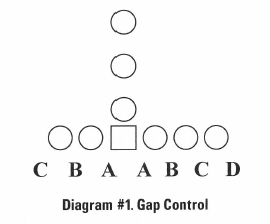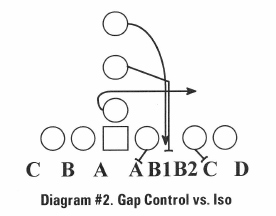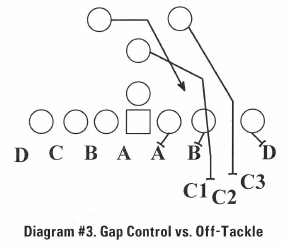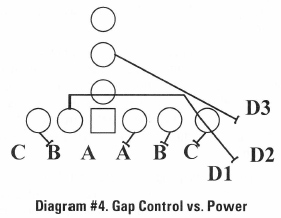| Defensive Concepts Against The Run
Originally Published - Nike 2012 Coach of the Year Clinics Notes - by Earl Browning
I have spoken at several clinics in the past. I am not sure if you have heard me before. I usually talk about offense, but today for the first time I am going to talk about defense. Defense has become a passion of mine recently. I am going to go through how we teach defensive concepts to our kids. We learned a big lesson in 2008. We got our butts kicked by East Grand Rapids High School for the second time in a row. I spent a whole lot of time in the off-season, looking at what we were doing defensively and why we were giving up 300 yards rushing in one half of a playoff game. We were not happy just to make the playoffs to face a perennial team that kicked our butts. This is when we made a big change, fundamentally, on what we were doing. To illustrate where we were before we made the changes to our program, I have some stats I want to share with you. I want to cover the two years before we changed our defense, and the two years after we made the changes in our defense. Before Changing Our Defense
After Changing Our Defense
We were not playing good defensively, and it was because of me overcoaching. I went to all of the clinics and drew up all of the fancy zone blitzes and thought that was the cool thing to do. I was not able to relate that to a high school kid for him to understand what he had to do. Some coaches have a different philosophy than what we now have. All we do now is talk gap control, and we do not blitz a lot. This year, we played 14 games. Every week when I would look at films on each of those teams, it was a priority that we had to stop the run. I know everybody says that, but it was so apparent each week from the films. Also, stopping the pass is a major priority for us each week. We see all types of offenses from week to week. We needed a way to communicate on defense and be able to play against all of the types of offensive concepts we face each week. If you were to look at us, you could call us a 3-4, a 4-3, or a 4-2-5 defense; we are a part of all of those at any one time. Where we have come to is gap control. I am going to take it to another level to where teams start changing the gaps. Where the offense starts inserting guys and creates a second B gap. This is what we preach and practice each and every day. This is all we do. Since the playoff game in 2008 after we made our changes, we have done much better against the run. These are the lessons we learned from our 2008 season:
You need to have the best 11 athletes on your football team, regardless of size, who can tackle, on defense. Our defensive line this year had all previously played as linebackers up until their junior year. The best defensive lineman I have had since the 2008 season was this year, and he will never play college football. He was a wrestler, and he was quick, athletic, played hard, and understood what he needed to do. In the past, we had bigger kids up front, but they could not run and, more importantly, when left unblocked could not make the tackle. When we saw that on film, it was a defining moment. We knew that had to change. We had to have players on the line who, when left unblocked at the point of attack, had to make the tackle. We sat down after that and figured out who our best 11 athletes were and determined what techniques we had to teach them to play a given position. Our assumption of defense: Our kids cannot defeat blocks and make plays. We must have an unblocked tackler every play. I tell our coaches all of the time to assume we do not have a single player on our team who can defeat a block and make a play. This is our assumption going into every game. If someone on the offense has the angle to make the block, he is going to make the block. We have to find a way to get an extra defender there who cannot be blocked. Through our defensive schemes, we have to have a guy there who they cannot account for. If they can account for all of our guys at the point of attack, we assume we are not going to be successful. Stating the obvious, these are our must-do's on defense:
If you go back and look at film of running plays that were successful against your defense, it is going to be because of a breakdown in at least one of these three things. It is not going to be because you picked the wrong blitz. It is not going to be because you were in the wrong front. It is going to be because your kids were out of position in their gap control responsibilities, or you have a kid playing who cannot make a tackle. If you are playing kids who cannot make a tackle, I do not have a magic formula that is going to answer your question on how to stop the run. Playing hard with effort is something you as coaches know about, but we coach the heck out of it. I put together a game tape of cut-ups of our kids giving great effort so they can see what I am talking about. You can preach it in practice and make them do up-downs when they do not do it, but until they can see how it can make a difference in a game, it is hard to get them to do it on every play. My JV baseball coach used to always say, "Thinking creates confusion." It is one of those Yogi Berra types of quotes. Thinking Creates Confusion
We used to do all of those pattern-reading drills in practice, where two becomes one and one becomes two and all of that. It just was not showing up on game night. A 17-year-old kid on Friday night in the lights is not, at the snap of the ball, going to say to himself, "Okay, where is number one and number two? Now, one became two, and two became three." We did all of that type of stuff. The kid is going to look at the quarterback and is going to play the ball. We decided we would work on getting good at playing the ball. The same thing can be said for up front. The only thing we teach every single defender on our football team is to understand gap control. We want to stick and rip everything into the gap where it belongs. I do not care if you are a defensive lineman or a linebacker. We want to rip through the gap because we do not feel we have a kid who can beat a block. An offense is going to understand their offense better than you could ever understand their offense. You, then, had better understand your defense better than they understand your defense. I am talking about your kids. As coaches, we often make the mistake of just telling our defense that the opponent's offense is going to run this play out of this set, and we stop there. You are not even telling your kids how to react to that play, or how to play against that play. I want our kids to know exactly where they fit in the scheme of our defense on each play in order to stop that play. Gap Control
We want to make sure all of our kids understand this, so we are going to coach that part of the defense this coming season every day. We want to make sure we understand gap control. Does a 17-year-old really understand what you mean by creating other gaps that were not there before? An iso play creates an extra gap that was not there before. How are we going to handle that? Are we still going to be able to handle all of the other gaps? The biggest critical error we can have in our defense is having two players in the same gap. This is where we have to get into preaching and practicing this every single day. This is basic, but let me put up the gap control so we are all on the same page (Diagram #1).
The best way for me to describe our basic gap control without any change in gaps is with the zone play. The zone play is trying to get one guy out of his gap. They are going to try to scoop or reach somebody. Our defensive linemen know the only thing they are going to work on forever is the reach or scoop block. We are not going to talk about wrong-arming or any of the other stuff until we know how to handle a reach block. We drill it every single day. The way the offense attacks teams that play gap control is to insert offensive players to create multiple gaps where there was only one gap when the ball was snapped. The iso is a good example as indicated by this look (Diagram #2).
Another example of the offense inserting players in gaps is the off-tackle play (Diagram #3). The two lead backs are inserting themselves into the C gap. They are going to block the defenders who fill those gaps.
One last example is the power play with the backside guard pulling (Diagram #4). With the lead fullback and the pulling guard, they are going to block at the point of attack to control the gaps. Everyone else blocks down on the play.
I see my time is up. Thank you very much. |







